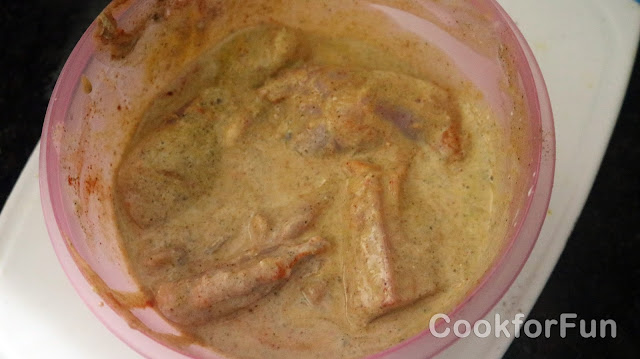I don't know about you but I love me some chicken biryani. It was brought to India by the Persians and over time, we have made it sort of our own . It is rice cooked with spices and marinated meat and when I say spices I mean a lot of spices . Before you proceed , disclaimer : this is no cake walk and requires patience and some preparation so don't expect to whip out a perfect biryani like a special effort dinner. This is more than that. Biryani can be considered somewhat like Brad Pitt of rice dishes , its that good! However, its not overly technical . Sure the list of ingredients is long, but it is worthed. So before I take you on a tour to biryani land , here are some technical points to remember :
- Whether using chicken or mutton ( a grown lamb) , make sure you use it on the bone and in large chunks. Bone has a lot of flavor and small pieces may cook to quick and turn dry or chewy.
- Choose the correct rice . Traditionally Basmati is used which is a long grain , fragrant variety of rice. It has less starch content making it fluffy and separated. Most short grain rice have a lot of starch and turn gluggy which is why they are perfect for dishes like risotto .

- Not overcooking the rice (or the meat) : Rice is par boiled then cooked in dum (steam) and considering basmati is a pretty delicate rice , you need to be careful not to overcook it. Check after 6 minutes of boiling , it should be only 70% cooked , which means it will still be resistant to crush.
- Frying the onions : The brown onions are an integral part of this dish. They impart flavor and to get that flavor , you need to fry the onions on low heat. Do not under any circumstances crank up the heat . Onions have natural sugars in them and when they are heated , the onions become sweet. However , we need to caramelise the sugars slowly and not burn them as they will give off a bitter taste to the rice.
Recipe : Chicken Dum Biryani
Prep time : 12 hours
Cooking time : 1.5 hours
Serves :6
Cuisine : Indian
Course : Main
Ingredients :
- 2 cups Basmati rice
- 500 grams chicken with bones
- 2/3 cup of yogurt + 1/4 cup milk
- 1 tsp ginger paste
- 1 tsp garlic paste
- 1/2 tsp of each of the following :
- Cumin powder
- Garam Masala powder
- Tumeric Powder
- Red Chilli Powder
- 1 tsp of coriander powder and chicken spice mix each
- Salt and Pepper to taste
- 18 green cardamoms + 15 cloves+ 5 one inch pieces of cinnamon + 4 bayleaves
- 2+4 tbsp of oil or ghee
- 2 large onions , sliced
- A large pinch of saffron
- 1/2 cup milk
- 3 soft boiled eggs
- A dough made of 1 cup of wheat flour and water
Procedure :
- Take your chicken , add the yogurt and milk. Add salt and pepper, cumin, coriander, garam masala, chicken spice mix, tumeric, red chilli powder, ginger paste and garlic paste. Mix thoroughly . Cover and marinate overnight in the fridge.
- Next morning. Wash the rice multiple times until the water runs almost clear and then soak the rice at room temperature until the grains swell and become opaque.
- Boil 8 cups of water with salt and whole spices , i.e. cardamoms, cloves, cinnamon and bay leaves. Add the rice and boil until rice is 70% cooked. This should be at 6-8 minutes on high heat. Drain ( you may add 2 tbsp of ghee at this point and mix the rice) Reserve until needed.
- Heat 4 tbsp of oil in a pan and add the slices onions with a pinch of salt . Cook on low , ocassionally stirring until the onions are browned . Drain on a kitchen paper.
- Soak the saffron in milk and let it sit.
- In a kadai/wok, heat the remaining oil and add the chicken with all the marinade. Cook on medium until the chicken is 70% cooked and most of the moisture has vaporised and the curry is separating oil at the edges. Remove from heat.
- Take a really thick , deep pot with a lid. Brush oil/ghee on the base and the sides. Place 1/rd of the rice . Place 3 pieces of chicken along with 1/2 the gravy (place the larger and tougher pieces like the thigh). Sprinkle 1/3rd of fried onions and few tbsps of the saffron infused milk. Repeat, place eggs in this layer too. Add the final layer of rice, onions and saffron milk.
- Roll a long log from the dough and attach it along the circumference of the pot. Place the lid. Cook the biryani on the lowest setting of the gas for about 30 minutes. Turn off the gas and let it sit on the burner for another 30 mins.
- Serve immediate with raita and papad.
Optional : If you prefer , you can use a few drops of rose water or kewda water. I don't prefer the aroma so I left it out.
What do you think of this recipe ??? Please rate and it would be even nicer if you left a comment and shared this recipe on your social media.















